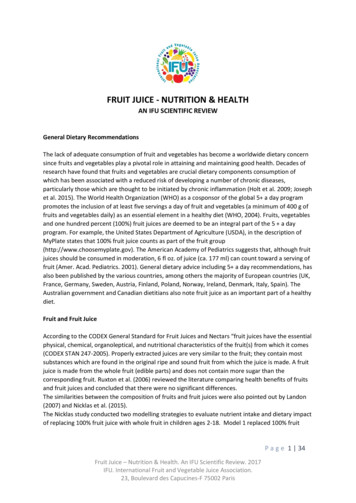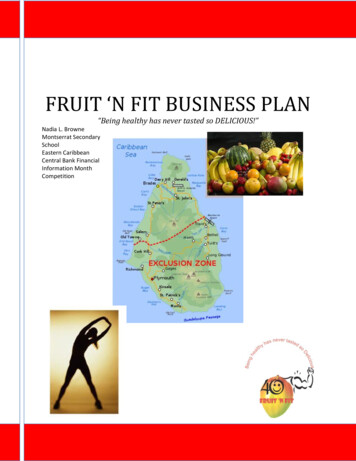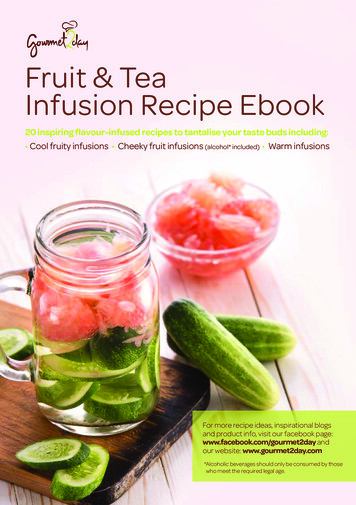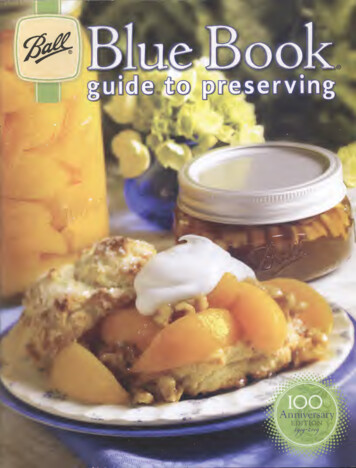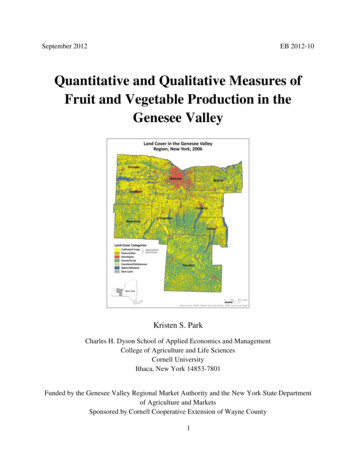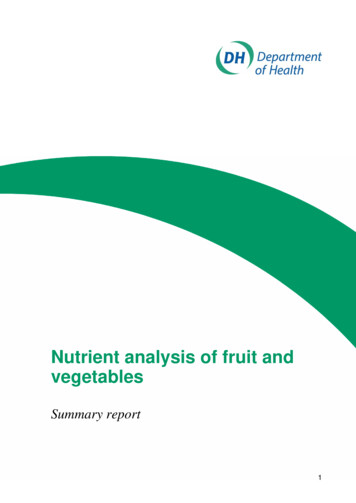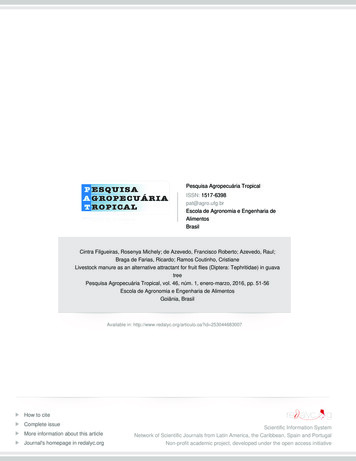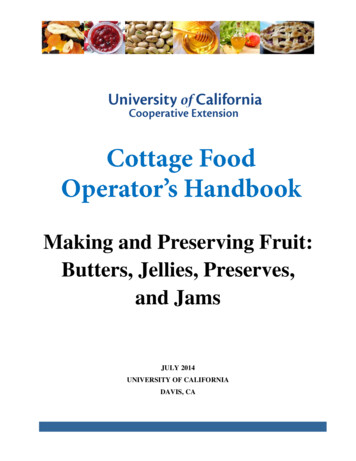
Transcription
Making and Preserving Fruit:Butters, Jellies, Preserves,and JamsJULY 2014UNIVERSITY OF CALIFORNIADAVIS, CA
UNIVERSITY OF CALIFORNIA COOPERATIVE EXTENSIONMAKING AND PRESERVING FRUIT: BUTTERS, JELLIES, PRESERVES AND JAMSAcknowledgementsThis handbook could not have been produced without the dedicated efforts of the followingUniversity of California Cooperative Extension educators who were members of Training Teamfor Cottage Food Operations: Project Director: Shermain Hardesty, Cooperative Extension Specialist-Agricultural andResource Economics, UC Davis and Leader, UC Small Farm ProgramDeborah Giraud, Farm and Community / Economic Development Advisor, Humboldt CountyConcepcion Mendoza, Nutrition, Family and Consumer Sciences Advisor, Shasta and TrinityCountiesDiane Metz, Emeritus Nutrition, Family and Consumer Science Advisor, Yolo and SolanoCountiesSusan Mosbacher, Program Representative for Master Gardener and Master Food Preserverprograms, Central SierraScott Oneto, Farm Advisor/Region Director, Central SierraDorothy Smith, Nutrition Family and Consumer Science Advisor, Central SierraJulia Van Soelen Kim, North Bay Food Systems Advisor, Marin, Sonoma and MendocinoCountiesSincere appreciation is also extended for the technical support provided by Linda Harris, FoodSafety and Applied Microbiology Specialist, Department of Food Science and Technology, UCDavis.Administrative support was cheerfully provided by Vera Allen, UCCE Central Sierra.This handbook was partially funded by a California Department of Food and AgricultureSpecialty Crop Block Grant.Brand names and company names are included for educational purposes. No endorsement isimplied nor is discrimination intended against similar products or services.Additional information regarding this project may be obtained by contacting Shermain Hardesty,shermain@primal.ucdavis.edu, or http://ucanr.edu/cottagefoods
UNIVERSITY OF CALIFORNIA COOPERATIVE EXTENSIONMAKING AND PRESERVING FRUIT: BUTTERS, JELLIES, PRESERVESAND JAMSTABLE OF CONTENTSDefinitions of Various Fruit-Based Products .1General Instructions & Steps in Jam or Jelly Making .3Packaging .6Storage .6Q & A.7Resources . 10Appendix .Jams and Jellies: Problems and Solutions . A121CFR150 . A3
UNIVERSITY OF CALIFORNIA COOPERATIVE EXTENSIONMAKING AND PRESERVING FRUIT: BUTTERS, JELLIES, PRESERVES AND JAMSMAKING AND PRESERVING FRUIT: BUTTERS, JELLIES, PRESERVESAND JAMSDefinitions of Various Fruit-based Products:Fruit butters, jellies, preserves and jams are foods having a variety of textures, flavors and colors.They are all produced by preserving the fruit with sugar, and are thickened or jellied to somedegree. These products have the following characteristics: Butters: pureed fruit cooked with sugar and sometimes juice, usually with added spices.The Cottage Food Law allows only certain fruits to be used in fruit butters. Also note theamount of sweeteners and pectin allowed. Butters generally have less sugar than jam. Jellies: gelatinous, clear and made from fruit juice and sugar, texture is firm and it holdsits shape. Follow the Cottage Food Law (CFO Law) to ascertain acceptable fruits allowedto be made into jellies and the proportions of fruit, sweetener and pectin allowed. Preserves: made from whole or cut up fruit in clear, slightly jelled syrup. Follow the CFOLaw to ascertain acceptable fruits and proportions. The CFO Law permits the inclusion ofdried fruits, but nuts are not allowed. Jam: crushed or chopped fruit that is cooked with sugar until it gels. Less firm than jelly.Follow the CFO Law to ascertain acceptable fruits and the proportion of fruit, sweetenerand pectin allowed. Conserves: preserves are made from a mixture of fruits and/or vegetables that may alsoinclude dried fruit or nuts. Again, follow the CFO Law to ascertain acceptable fruits andproportions. The CFO Law permits the inclusion of dried fruits, but nuts are not allowed. Marmalade: sliced, ground, or diced citrus fruit; suspended in clear jelly. Again, followthe CFO Law to ascertain fruits and proportions.Pectin jellies and jams are recognizable because they are thickand gelatinous. This state is reached by a combination of fruitwith three ingredients: pectin, acid and sugar. Most fruit jelliesand jams contain about one percent pectin. It is naturallyoccurring and found in many fruits, some containing enoughnatural pectin to make finished product. Many others requireadded pectin, especially when making jelly.Pectins are complex chemicals whose jelling ability is standardized in products made for use injelly and jam. However, the ability of these products to jell is gradually lost if stored too longbefore use, or if the mix is heated too long before it is filled into jars.The amount of pectin recommended may vary from brand to brand. Unused pectins should bestored in a cool, dry place so they will keep their gel strength. Most pectin only work when usinga large amount of sugar although some low sugar varieties of pectin are available. They aredesigned for use with one-third less sugar than the standard pectins. Other pectins will jellwithout any sugar. (Cottage Food Operators: Only low sugar fruit butters are allowed; no lowsugar jams or jellies are allowed).When using a traditional form of pectin, you have two forms to choose from—dry powdered orliquid. These pectins are made from apples or citrus fruits. Recipes are specifically designed forthese traditional pectins; they must be used with the correct form of pectin, method of1
UNIVERSITY OF CALIFORNIA COOPERATIVE EXTENSIONMAKING AND PRESERVING FRUIT: BUTTERS, JELLIES, PRESERVES AND JAMSpreparation, amount of sugar, and amount of fruit. The amount of pectin recommended may varyfrom brand to brand. If you are using traditional pectin, do not increase or reduce the amount ofsugar given in the recipe. It takes a lot of sugar to form a gel. If you use less, you will end upwith syrup or a very soft gel. If you use too much, some sugar may remain undissolved. Thesecrystals will leave a sandy or gritty feel in the mouth. Do not double a recipe. It takes too muchcooking time, which breaks down the pectin resulting in soft and runny product. Boiling longeronly worsens the problems and may change the flavor and darken the color.These fruits usually contain enough pectin and acid for jellyApples, tartGrapes, Eastern ConcordBlackberries, tartLemonsCrabapplesLoganberriesCranberriesPlums, most varietiesCurrantsPrunes, sourGooseberriesQuinceThese fruits usually are low in pectin or acidApples, ripeGrapefruitBlackberries, ripeGrape juice, eastern ConcordCherries, sourGrapes, CaliforniaElderberriesOrangesThese fruits always need added pectin, acid, or bothApricotsPearsFigsPomegranatesGrapes, western id: Cooked fruit products made with pectin have a pH between 3.0 and 3.3. Below 3.0, thejelly weeps or forms droplets of water on its surface. If above 3.3 pH, the jelly will be weak andincreasingly runny.Acid is needed for flavor and for gel formation. The acid content varies in fruits and is higher inunder ripe fruits. Nearly all fruits need added acid. Commercial pectin products also containacids.If lemon juice is needed for additional acid, commercial lemon juice should be used. If desired,⅛ teaspoon of citric acid can be substituted for each tablespoon of lemon juice.Sugar: Sugar helps in gel formation, serves as a preserving agent, and contributes to the flavorof the jellied product. It also has a firming effect on the fruit, a property that is useful in makingjams. Sugar is a very important factor in determining the shelf life of preserved fruit products.Corn syrup, honey, other nutritive sugars, and low-calorie sweeteners may not be substituted onefor one for sugar in recipes. If you wish to use these sweeteners, it is best to use recipesspecifically designed for them.2
UNIVERSITY OF CALIFORNIA COOPERATIVE EXTENSIONMAKING AND PRESERVING FRUIT: BUTTERS, JELLIES, PRESERVES AND JAMSCalifornia’s CFO Law requires using the fruit-to-sugar proportions specified in the Code ofFederal Regulations (CFR), Title 21, Section 150 for various preserved fruit products; thesestandards are displayed in Appendix 4A at the end of this chapter. These proportions are basedon the weight of the fruit and sugar, rather than volume (cups). For example, strawberry isclassified as a Group 1 fruit (see Appendix 4A, page 10). CFR 21 150.160 d(1) requires that jamsmade with Group 1 fruit must have 47 part of fruit to 55 parts of saccharine (Appendix 4A, page11). If a traditional recipe calls for 4 cups of hulled and crushed strawberries, the amount ofsugar can be calculated using the following steps.1.2.3.4.5.6.7.Measure the weight of 4 cups of strawberries (34 ounces)Calculate the ratio of 47 parts fruit to 55 parts sugar: 47 / 55 .85Let S be the number of ounces of sugar that need to be calculated.State the equivalent ratios: 34 / S 47 / 55 .85To solve for S, multiply both sides by S: S X 34 / S .85SSimplify to 34 .85SDivide both sides by .85: 34 / .85 .85S/.85, which simplifies to 40 SSo 47 parts of fruit to 55 parts of sugar means that, when using 34 ounces of strawberries, 40ounces of sugar must be added.General Instructions & Steps in Jam or Jelly MakingFruits can be frozen or canned for making jams or jellies at a more convenient time. Whenfreezing or canning your own fruits to make jams or jellies later, preserve the fruits unsweetened.Frozen fruits tend to collapse when thawed and this makes accurate measurements difficult.Therefore, measure amounts needed before freezing, package, mark, and freeze. Commerciallycanned or frozen fruit juices frequently have the pectin removed. Jellies made with these juiceswill be soft in texture. Use reliable recipes with detailed instructions. Measure ingredientscarefully. Remember—fruit, pectin, acid, and sugar all have to be present in the right amountsfor the jelly or jam to gel.For acceptable Cottage Foods fruit butters, jams, jellies and preserves,traditional recipes cannot be used ‘as is’. Because the regulations require weight measurementsbe used, the CFO will have to weigh the fruit and the sugar to get the approved proportions.Usually, a person can start with a standard pectin recipe and weigh the amounts that the recipe(usually cups and tablespoons) uses. Then test to see if these measurements are in the correctproportions for acceptable Cottage Food products.Once the correct weights of fruit (or juice) and sugar are ascertained (such as 34 ounces ofstrawberries to 40 ounces of sugar), use the instructions for the recipe you were ‘basically’following.1.2.3.4.Wash and dry clean canning jars. They do not need to be pre-sterilized if more than 10minutes in a boiling water canner.Prepare the two-piece lids according to the manufacturer’s instructions.Prepare butter, jam, jelly, or preserves according to Cottage Food recommendationsbased upon a recipe for the product. Usually, a commercial pectin product will help tohave a standard product with more yield in less time than other methods.Boil for recommended time and quickly skim off foam. Add ½ teaspoon vegetable oil toprevent foam formation, if desired. Animal fats such as butter are not allowable byCottage Food Law.3
UNIVERSITY OF CALIFORNIA COOPERATIVE EXTENSIONMAKING AND PRESERVING FRUIT: BUTTERS, JELLIES, PRESERVES AND JAMS5.6.7.8.9.10.11.12.13.Fill jars, leaving ¼ inch headspace.Wipe the sealing surface of the jars with a dampened paper towel, to remove anything onthe rim that might interfere with sealing.Place prepared lids and rings on the jars. Screw finger tight but do not force too tightly.Process 10 minutes in boiling water canner with water at least one inch above tops ofjars. Process 15 minutes if elevation is 1,001 to 6,000 ft. and 20 minutes if above 6,000 ft.Remove jars from canner, do not tip, keep them upright. Do not wipe off water, it willevaporate. Place on a soft towel and keep out of drafts so the jars can cool undisturbed.Cool jars upright for 12-24 hours.Remove screw bands.Wash jars and lids to remove all residue.Label and store in a cool, dry place. For CFO products, labeling instructions must befollowed carefully.Making Jelly with Added Pectin: Follow Cottage Food Law requirements for makingacceptable jelly. Weigh the juice and the sugar to obtain the correct proportions. Use only firmfruits naturally high in pectin. Select a mixture of about ¾ ripe to ¼ under ripe fruit. Wash allfruits thoroughly before cooking. Crush soft fruits or berries; cut firmer fruits into small pieces.Some recipes can be found that utilize canned or frozen juices that yield satisfactory products. Ingeneral, commercially canned or frozen fruit juices will not make satisfactory jellies unlesspectin is added because the natural pectin has been removed. Using the peels and cores will add pectin to the juice during cooking. Add water to fruits that require it as listed in the following table.General Guidelines for Extracting Juices and Making Jelly (will vary for Cottage Foods)Ingredients added to eachYield from 4To Extract Juicecup of strained juicecups of juiceCups of water Minutes toto be added simmer fruitper lb. of juicebeforeor fruitextracting juiceApplesSugar (cups)Lemon Juice(tsp.)1/2 pints120-253/41 1/2 03/408-9 Put fruit and water in large saucepan and bring to a boil. Then simmer according to timelisted until fruit is soft, while stirring to prevent scorching.One pound of fruit should yield at least one cup of clear juice.4
UNIVERSITY OF CALIFORNIA COOPERATIVE EXTENSIONMAKING AND PRESERVING FRUIT: BUTTERS, JELLIES, PRESERVES AND JAMS When fruit is soft, strain through a colander. Then strain through a double layer ofcheesecloth or a jelly bag. Allow juice to drip through, using a stand or colander to holdthe bag. Pressing or squeezing the bag or cloth will cause cloudy jelly.Use no more than six to eight cups of extracted fruit juice at a time. Measure fruit juice,sugar, and lemon juice according to the recipe and heat to boiling. Stir until the sugar isdissolved. Boil over high heat to the jellying point. To test for doneness, use one of thefollowing methods.Temperature test: Use a jelly or candy thermometer and boil until mixture reaches the propertemperature for your altitude, as indicated in the following chart.AltitudeSea1,000Level ft.Temperature 220 F 218 Fneeded2,000ft.216 F3,000ft.214 F4,000ft.212 F5,000ft.211 F6,000ft.209 F7,000ft.207 F8,000ft.205 FSheet or spoon test: Dip a cool metal spoon into the boiling jelly mixture. Raise the spoon about12 inches above the pan (out of steam). Turn the spoon so the liquid runs off the side. The jelly isdone when the syrup forms two drops that flow together and sheets or hangs off the edge of thespoon.Remove from heat and quickly skim off foam. Then promptly fill canning jars with jelly using ameasuring cup or ladle the jelly through a wide-mouth funnel, leaving ¼ inch headspace. Adjustlids and process ten minutes in a boiling water canner. (Adjust processing time for elevation, ifneeded.)Making Jam Without Added Pectin: For best flavor, use fully ripe, but not overripe fruit.Rinse fruit thoroughly before cooking. Do not soak. Remove stems, skins, and pits from fruit; cutinto pieces and crush. For berries, remove stems and blossoms and crush. Seedy berries may beput through a sieve or food mill. Measure crushed fruit into a large saucepan using theingredients and quantities required by Cottage Food Law. Add sugar and bring to a boil while stirring rapidly and constantly. Continue to boil until mixture thickens. Use one of the following tests to determine whenjams are ready to fill. Remember to allow for thickening during cooling.Temperature test: Use a jelly or candy thermometer. See temperatures at various altitudes asdescribed above for jelly.Freezer test: Place a small plate in the freezer, remove the jam mixture from the heat and pour asmall amount onto cold plate. Put it in freezer for a couple of minutes. Tip the plate and if themixture doesn’t run and is jelly-like, it is ready to fill into the jar.Adjusting Firmness in Jellies, Jams, and Preserves: Jelly will be medium firm if you areusing fruit with average jellying properties. Fruits differ so it’s not possible to develop exactformulas that will produce the same result over and over.If your first batch is too soft or firm, adjust the proportions of fruit or the cooking time for thenext batch.5
UNIVERSITY OF CALIFORNIA COOPERATIVE EXTENSIONMAKING AND PRESERVING FRUIT: BUTTERS, JELLIES, PRESERVES AND JAMSIn products made with added pectin, use ¼ to ½ cup more fruit or juice to make a softer product.Use ¼ to ½ cup less fruit or juice to make a firmer product. When making Cottage Foodsallowable preserved fruit products (Butters, Jams, Jellies, Preserves), one must follow theallowable proportions of fruit, sweetener, and pectin.In products made without added pectin, shorten the cooking time to make a softer product.Lengthen the cooking time to make a firmer product.PackagingThe boiling water processing requirements for fruit jams, jellies, and other preserved fruitproducts make glass the only financially viable packaging option for cottage food producers.Glass jars are available in a variety of sizes, colors and shapes, but cost considerations causemost CFOs to use clear Mason jars. Their thick walls easily withstand the high temperatures offruits cooked with sugar. When pouring jams or other preserved fruit products into jars, it is veryimportant to wipe the jar rims using a clean, damp paper towel to ensure that none of the jam isleft on the sealing surface and interferes with the lid sealing properly.StorageLike all other cottage foods, California’s Cottage Food Law requires that jams and otherpreserved fruit products must be stored in the home kitchen or in a storage area attached to thehome that is used exclusively for storage. Storage areas must be maintained free of rodents andinsects.Jams and other preserved fruit products should be stored in a cool, dark, dry place, between 5070 F and consumed within a year. Over extended periods of time, changes in color, flavor,texture and nutrient content of home-canned preserved fruit products are inevitable. Do not storejars above 95 F or near hot pipes, a range, a furnace, or in direct sunlight. Under theseconditions, food will lose quality in a few weeks or months and may spoil. Accidental freezing ofjams and other preserved fruit products will not cause spoilage unless jars become unsealed andcontaminated. If jars must be stored where they may freeze, wrap them in newspapers, placethem in heavy cartons, and cover with more newspapers and blankets. Dampness may corrodemetal lids, break seals, and allow recontamination and spoilage.6
UNIVERSITY OF CALIFORNIA COOPERATIVE EXTENSIONMAKING AND PRESERVING FRUIT: BUTTERS, JELLIES, PRESERVES AND JAMSSome Common Questions and AnswersQ. Can I use honey in place of sugar when I make jams and jellies?A. In a recipe with no added pectin, you may replace half the sugar with honey. In a recipe withadded pectin, you can replace approximately one-fourth of the sugar with honey. Jams andjellies made with honey will have a darker color and slightly different flavor than those madewith sugar.Q. Can I use corn syrup in place of sugar when I make jams and jellies?A. In jellies and jams with no added pectin, you can replace one-fourth of the sugar with lightcorn syrup. In recipes with added powdered pectin, you can replace up to one-half of thesugar in jelly and jam with light corn syrup. In recipes with liquid pectin, you can replace upto 2 cups of the sugar with light corn syrup. Doing any adjustments of this nature, maycompromise the proportions allowed for Cottage Food Products.Q. Why are my double batches of jelly unsuccessful?A. The cooking time changes in relation to the proportion of ingredients when you increase therecipe. The bigger the batch, the worse the problem will be. Small batches of jelly are easierto handle and are more apt to turn out successfully.Q. Why is it necessary to process jellies, conserves, preserves, and marmalades?A. Mold and other spoilage microorganisms can grow if the jar is not sealed tightly to excludeair. Water bath processing produces a strong vacuum seal.Q. Can ordinary cooked jams and jellies be frozen successfully?A. Yes. Allow room for expansion as they freeze however. This usually means increasingheadspace to ½ inch or more. You may wish to freeze overnight and then cover jars withtight-fitting lids to reduce jar breakage. The color, flavor, and texture of jams and jelliesstored in the freezer are excellent.Q. How long can powdered or liquid pectin be stored?A. Pectin should be stored in a cool, dry place so that it will keep its jell strength. It should notbe held over from one year to another.Q. My jam tastes like wine; what happened?A. It has fermented due to an improper seal or due to storing too long in the refrigerator.Q. Why is my jelly bubbly?A. If the bubbles are active, it's a sign of spoilage—throw it out! Stationary bubbles indicate thejelly was poured too slowly from too great a height into the jars and air was trapped.Q. Can I rescue my over-cooked jelly?A. Unless it tastes scorched or burned, it can be diluted with water and heated to make pancakesyrup. Follow the directions more carefully next time.7
UNIVERSITY OF CALIFORNIA COOPERATIVE EXTENSIONMAKING AND PRESERVING FRUIT: BUTTERS, JELLIES, PRESERVES AND JAMSQ. Can fruit juice or fruit be canned or frozen to be made into jelly or jam at a later time?A. Definitely. In fact, jellied products are best not stored longer than 6 months. If you add sugarto the juice or canned fruit, be certain to label the amount added.Q. What can be done to make soft jellies firmer?A. Measure jelly to be recooked. Work with no more than 4 to 6 cups at a time. Note: Addingadditional sugar, acid and pectin will affect the proportions allowable for Cottage Foodproducts.To remake with powdered pectin: For each quart of jelly, mix ¼ cup sugar, ½ cup water, 2tablespoons commercial lemon juice, and 4 teaspoons powdered pectin. Bring to a boil whilestirring. Add jelly and bring to a rolling boil over high heat, stirring constantly. Boil hard ½minute. Remove from heat, quickly skim foam off jelly, and fill sterile jars, leaving ¼ inchheadspace. Wipe jar rims with damp clean cloth or paper towel. Use newly prepared lids andrings. Process for 10 minutes at sea level or more per higher elevations.To remake with liquid pectin: For each quart of jelly, measure ¾ cup sugar, 2 tablespoonscommercial lemon juice, and 2 tablespoons liquid pectin. Set aside. Bring jelly to boil overhigh heat, while stirring. Remove from heat and quickly add the sugar, lemon juice, andpectin mixture. Bring to a full rolling boil, stirring constantly. Boil hard for 1 minute.Quickly skim off foam and fill sterile jars, leaving 1/4-inch headspace. Wipe jar rims withdamp clean cloth or paper towel. Use newly prepared lids and rings. Process for 10 minutesat sea level or more per higher elevations.To remake without added pectin: For each quart of jelly, add 2 tablespoons commerciallemon juice. Heat mixture to boiling and boil for 3 to 4 minutes. Use temperature or spoontest (described earlier in this lesson) to determine jelly doneness. Remove from heat, quicklyskim off foam, and fill jars, leaving ¼ inch headspace. Wipe jar rims with damp clean clothor paper towel. Use newly prepared lids and rings. Process for 10 minutes at sea level ormore per higher elevations.Q. Is there any way to remove sugar crystals that have formed in my jelly?A. Too much sugar may have been added or the jelly was cooked too long. There is no easymethod to remove these crystals. You can try remaking the jelly with added water. Start byadding about ½ cup boiling water to the amount of jelly produced in the original recipe. Ifyou had a firm jelly, reheat it with the added water by rapidly bringing it to the boiling pointwhile stirring constantly. Remove from heat and fill jars, leaving ¼ inch headspace. Processthe jars for 10 minutes in a boiling water canner. If your jelly was not firm enough the firsttime, add four teaspoons powdered pectin per quart of jelly with the water and boil hard forone minute before filling jars, or add two tablespoons liquid pectin when the jelly and waterreach boiling and continue to boil hard for one minute before filling jars. Wipe jar rims withdamp clean cloth or paper towel. Use newly prepared lids and rings. Process for 10 minutesin a boiling water canner at sea level (adjust for elevation, if needed).8
UNIVERSITY OF CALIFORNIA COOPERATIVE EXTENSIONMAKING AND PRESERVING FRUIT: BUTTERS, JELLIES, PRESERVES AND JAMSQ. What is a full rolling boil?A. It is a bubbling, steamy boil that no amount of stirring can stir down. A very large saucepanis recommended to prevent boiling over.Q. How can I decrease the amount of foam which forms on my jelly?A. The foam that forms from the boiling process will not hurt the product, but it will detractfrom the appearance. Adding ½ teaspoon oil may help eliminate this foam.9
UNIVERSITY OF CALIFORNIA COOPERATIVE EXTENSIONMAKING AND PRESERVING FRUIT: BUTTERS, JELLIES, PRESERVES AND JAMSResourcesSo Easy to Preserve. University of Georgia (http://setp.uga.edu/)USDA Complete Guide to Home Canning, 2009 revision. USDA AIB 539.http://nchfp.uga.edu/publications/publications usda.html Let's Preserve: Jam, Jellies and Preserves. . University of Nebraska Extension. EC .pdf10
UNIVERSITY OF CALIFORNIA COOPERATIVE EXTENSIONMAKING AND PRESERVING FRUIT: BUTTERS, JELLIES, PRESERVES AND JAMSJams and Jellies: Problems and SolutionsProblemCauseFormation ofExcess sugarsugar crystalsUndissolved sugar sticking tosides of kettlePreventionFollow recipe exactly.Wipe side of pan free of crystals with dampcloth before filling jars.Mixture cooked too slowly or too Cook at a rapid boil. Remove from heatlongimmediately when jellying point is reached.Cook until sugar has completely dissolvedand mixed with fruit juice.Mixture cooked too littleSyneresis or"weeping"Products are safe to eat.Excess acid in juice makes pectin Maintain proper acidity of juice.unstableStorage place too warm or storage Store in a cool, dark, dry place.temperature fluctuatedToo softProduct was sealed with paraffin Seal with lids and process."Weepy" products are safe to eat.Overcooking fruits to extract juice Avoid overcooking as this lowers thejellying capacity of pectin.Incorrect proportions of sugar andjuiceFollow recommended instructions.Undercooking causinginsufficient concentrationCook rapidly to jellying point.Avoid using fruit that is overripe. Addlemon juice if needed.Insufficient acidMaking too large a batch at onetimeToo stiff ortoughUse only 4 to 6 cups of juice in each batchof jelly.Products are safe to eat.Cook jelly mixture to a temperature 8degrees higher than the boiling point ofwater for jelly.OvercookingToo much pectin in fruitUse ripe fruit.Products are safe to eat.A1
UNIVERSITY OF CALIFORNIA COOPERATIVE EXTENSIONMAKING AND PRESERVING FRUIT: BUTTERS, JELLIES, PRESERVES AND JAMSProblemCloudyCauseFruit was greenPreventionUse firm, ripe fruit, or slightly under ripe.Imperfect strainingDo not squeeze juice; let it drip throughjelly bag.Jelly allowed to stand before itwas poured into jars and pouredtoo slowlyHold kettle close to top of jar and pour jellyquickly into jar.Follow recommended methods to getairtight seal.If product does not have airtightseal, may denote spoilage. If there Cloudy products are safe to eat unless thereare moving bubbles, do not use. are moving bubbles or product appearsspoiled.Mold (denotes Imperfect sealSeal with lids and process in boiling waterspoilage; do notbath.use)Paraffin seal not airtight, reusing Do not use paraffin; use 2-piece lids andparaffinprocess in boiling water bath.FadingLack of sanitationSterilize jars if processing time is less than10 minutes.Too little sugarFollowing processing recommendations forlow-sugar jellied products.Storage place too warm or toolightMoldy jams and jellies are not safe to eatand should be discarded.Store in cool, dark, dry place 35-50 F.Use oldest products first.Storage too longFruit floats injamUnder ripe fruitProducts are safe to eat.Use ripe fruit.Not thoroughly crushedCrush fruit uniformly.UndercookingCook rapidly following instructions.Improper packing in jarsProducts are safe to eat.A2
UNIVERSITY OF CALIFORNIA COOPERATIVE EXTENSIONMAKING AND PRESERVING FRUIT: BUTTERS, JELLIES, PRESERVES AND JAMSProblemBubblesCausePreventionKettle was not held close to top of Hold kettle close to top of jar and pour jellyjar as jelly was poured, or jellyquickly into jar.was poured slowly and air becametrap
The Cottage Food Law allows only certain fruits to be used in fruit butters. Also note the amount of sweeteners and pectin allowed. Butters generally have less sugar than jam. . ⅛ teaspoon of citric acid can be substituted for each tablespoon of lemon juice. Sugar: Sugar helps in gel formation, serves as a preserving agent, and contributes .
